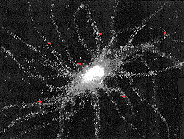 123 Compute.Net
123 Compute.Net 
 123 Compute.Net
123 Compute.Net 
Tools
Dreaming Computers I Knocking on Heaven's Gates: Reflections on Immanuel Kant's Kingdom of Ends in the Age of Computers II The Guardian of Sleep INTRODUCTION Is the human brain a useful model for a thinking machine? We used to think so. For hundreds of years we've imagined recreating ourselves, or at least our rational selves, in computing devices, and in the last sixty years we've actually begun to do it. The metaphorical imagination works in both directions, of course: The language we use to describe our new creation now permeates discussions about how our own brains work. When we hear talk of neural networks and memory banks, parallel processing, and "down time", we can no longer be sure exactly who is talking- neurophysiologists or computer scientists. A sort of mirroring is going on. We are examining ourselves through the very challenge of making these extraordinary machines. And we are at the point now where some people wonder how much longer it will be before the machines start examining us. Increasingly, both brains and computers are viewed as sharing a fundamentally similar design. "We as human beings may use a parallel algorithmic processing device with multiple specialized sub-processors but like living things themselves, the whole is more than the sum of its parts... This quote is from an amazon.com reader's review of Daniel Dennett's Darwin's Dangerous Idea. George Dyson, in Darwin Among the Machines, puts it more concretely: "Turing developed the concept of 'unorganized Machines'... He considered a simple model with units capable of two possible states connected by two inputs and one output each, concluding that 'machines of this character can behave in a very complicated manner when the number of units is large.' [which is] ('about the simplest model of a nervous system')... [It] could be made self-modifying and, with proper upbringing, could become more complicated than anything that could be otherwise engineered." But there are differences between brains and computers. One of the least discussed is that brains are a computing device that requires sleep. It seems to me that anyone looking for clues about how natural intelligence works would take sleeping and dreaming very seriously. They would ask what role these states play in the deep structure of the biology of intelligence. They would ask if there are processes they mediate that our minds require, processes that go beyond maintaining our flesh to specifically enhancing our range of thought. For example, the sleep stage during which we dream (REM) appears to be necessary for the proper development of the maturing brain, but does it also play a direct role in the intelligence that the mature brain enables? Right now artificial intelligence folks work on programming solutions to deterministic games that enable processors to learn in a universe of shifting “fitness functions”. These games and modes of learning are analogous to what we do when we "reason a problem through", which is how we thought to apply them to machines in the first place. For example, computers can be programmed to explore the classic human question, "how does that work?" by initiating a series of Boolean logic statements of the form: "If....then...., else......". But are we on the verge of creating flexible machines that can not only learn, but also anticipate and self-correct? Are we initiating processes that may create an "inner voice" for our computers, a voice that listens to a "self"? In asking these questions I am in the firm grip of my own metaphorical imagination. I want to examine not only my rational self, but my intuitive self. I want to understand any claims that my physical brain enables mind, and may eventually be understood to enable something resembling "self" or "soul" as well. -Léa Park References The following are a selection of articles and books touching on the issues raised above. These are all "popular" accounts, written for the general public, for peole who have no special expertise in any of these areas. As I read them I am creating "Abstracts" in the form of collapsible outlines of (mostly) direct quotes, together with my own bracketed [...] comments, using UserLand's Frontier scripting program. Unfortunately the collapsible feature of these outlines cannot yet be rendered on the Web, but I will continue to post them here as a resource for myself and for any visitors interested in these topics. To reach an abstract, click on the reference title. The Mind's Past by Michael Gazzaniga. University of California Press, 1998 The author is an eminent neurophysiologist who's done lots of work with split brain patients. In an era, now ended, when cutting the bridge of tissue connecting the brain's two hemispheres was a treatment for epilepsy, he took advantage of these "natural experiments" to examine brain function. His great discovery is our left brain's Interpreter. Is dreaming our Interpreter hard at work, displaying its most consummate artistry? The Enchanted World of Sleep by Peretz Lavie. Yale University Press, 1996 Dr. Lavie is the head of the Sleep Laboratory and a professor of Biological Psychiatry at the Technion-Israel Institute of Technology in Haifa. His book provides insights about the impact of sleep on intelligence. Here are some of the questions I brought to my reading: Awakening to Sleep by Verlyn Klinkenborg. (New York Times Magazine, January 5, 1997) The author, a journalist, asks eminent sleep experts what is sleep for. The article's last paragraph is most provocative. Reflecting on research suggesting that "We've jettisoned 6 hours of quiet winter rest" each winter night, the author quotes one source as follows: " 'It is tempting to speculate,' Wehr writes, 'that in prehistoric times this arrangement [14 hours of sleep/semi-sleep] provided a channel of communication between dreams and waking life that has gradually been closed off as humans have compressed and consolidated their sleep. " 'If so, then this alteration might provide a physiological explanation for the observation that modern humans seem to have lost touch with the wellspring of myths and fantasies.' " Evolving a Conscious Machine by Gary Taubes. (Discover Magazine, June 1998) An interview with researchers who program Field Programmable Gate Array chips.(FPGA's) to process evolutionary algorithms. The goal is to develop self-evolving hardware by having it solve problems. Darwin Among the Machines by George B. Dyson, Perseum Books, 1997. A wonderfully provocative and readable book that explores the idea that mind is a result of simple selective rules at work amongst simple entities such as neurons or circuits. Evolution works upon this simplicity to give rise to mind, which is entities self-organizing into networks. Throughout Dyson explores this great mystery: "[What is] the invisible ingredient that leads from the predictability of logic to the unpredictability of mind?" "'For those who fear mechanistic explanations of the human mind, our ignorance of how local interactions produce emergent behavior offers a reassuring fog in which to hide the soul.'" Soul is also mentioned by Leibniz, arguing in 1716 against Hobbesian materialism: "One of their sect could easily persuade himself into believing that idea of some of the ancient writers...according to which souls are born when the machine is organized to receive it, as organ-pipes are adjusted to receive the general wind." "It is surprising that noncomputable functions, which outnumber computable ones, are so hard to find... "We either inhabit a largely computable world or have gravitated toward a computable frame of mind." [I think we've definitely gravitated....] "Higher-level representations... constructed in a neural network are not...step by step processes ...but [constructed] from the relations between dynamic local maxima and minima generated by a real-time, incomprehensibly complex version of one of von Neumann's games." "Consciousness may be identified with rate of transmission of information from one system to another." (Irving J. Good, colleague of Alan Turing, p.205) Boolean logic [also] "assumes as initial conditions only the existence of duality- the distinction between nothing and everything; between true and false, between on and off; between the numbers 0 and 1. [Might this be the beginning of a modern argument for the necessary existence of Another? See Martin Buber's I and Thou.] See also von Neumann on the need for a "primary automaton" working with/on a "matrix of units", resulting in interactions and "...ambiguities... [and even] conflict...that somehow bind the ingredients of logic...into the cathedral perceived as mind." (p. 110). " 'Perhaps the consciousness of animals is more shadowy than ours and perhaps their perceptions are always dreamlike....On the opposite side, whenever I talked with the sharpest intellect whom I have known- with von Neumann- I always had the impression that only he was fully awake, that I was halfway in a dream.' ", (p.77) Dreams are also mentioned by Lewis Fry Richardson, Olaf Stapleton's companion in the Friends' Ambulance Unit in which they both served during WWI: "The damp, secluded outpost suited Richardson, who cultivated an 'intentionally guided dreaming" that thrived in isolation. 'If the machine ran entirely of its own accord, one would have no control, and the dream would be out of touch with reality,' he explained. 'It is the 'almost' condition that is advantageous for creative thinking...." (p.196) Online Articles: The Digital Philosopher: Atlantic Unbound's Harvey Blume interviews Daniel Dennett on robotics, mind, and evolution. (12/9/98) "Hello, Hal", called "Creating a Monster" in New York Times Book Review print version, examines mind/machine issues in three new books by experts in artificial intelligence. The reviewer is Colin McGinn, professor of philosophy at Rutgers University. (1/3/99)
Photo at Top of this page is "Wet sand cupped, squeezed, thrown out of water" from Stone by Andy Goldsworthy. Goldsworthy arranges natural objects into beautiful patterns and then photographs them. "I need to understand the nature that is in all things. Stone is wood, water, earth, grass.." This particular photograph is attributed to Judith Goldsworthy. Perhaps it's a picture of the artist, playing.
Created 11/18/98. Last updated 3/10/99. Email any comments or questions to lpark@123compute.net
Tools